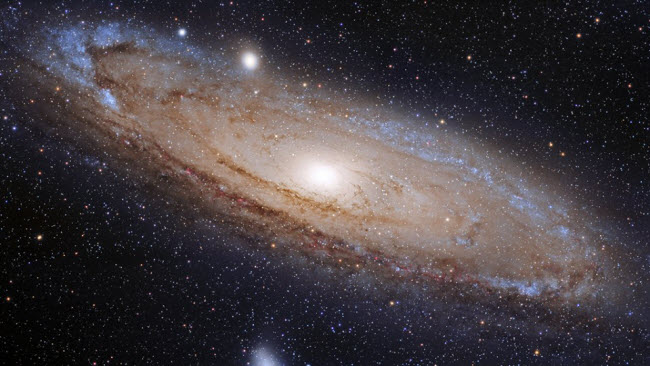The Andromeda Galaxy is the closest large spiral galaxy to our Milky Way. Aside from the Large and Small Magellanic Clouds, which are visible from the Southern Hemisphere, Andromeda is the brightest external galaxy and one of the few that can be seen with the naked eye from Earth on moonless nights. Named after the Phoenician princess who was the wife of the Greek hero Perseus in mythology, Andromeda is also known by its astronomical designation, Messier 31 or M31, indicating its place in the famous catalog of nebulae and star clusters compiled by the French astronomer Charles Messier. Amateur astronomers often observe Andromeda through telescopes and binoculars, though it is an independent galaxy that is expected to collide with our Milky Way in about 4 to 5 billion years, eventually merging to form a giant elliptical galaxy.
Early Observations of Andromeda

The first known record of the Andromeda Galaxy dates back to 964 AD, when Persian astronomer Abd al-Rahman al-Sufi described it as a “small cloud” in his Book of Fixed Stars. In 1612, German astronomer Simon Marius provided an early telescopic description of it. Charles Messier later cataloged Andromeda as M31 in 1764, when it was thought to be the Great Andromeda Nebula—a glowing patch of gas or a forming solar system within the Milky Way. There was much debate over whether this spiral nebula, along with others, was within our galaxy or beyond it, until the 1920s when astronomer Edwin Hubble finally confirmed that Andromeda lies outside the Milky Way.
Where Is Andromeda Located?
Andromeda is part of the Local Group, a collection of galaxies on the outskirts of a larger cluster called the Virgo Cluster, which consists of several thousand galaxies. Within the Local Group, Andromeda is the largest galaxy, alongside the Milky Way and about 30 smaller galaxies. Both Andromeda and the Milky Way have around 12 satellite galaxies each, containing enough mass to form billions of stars.
Andromeda is approximately 2.48 million light-years from Earth and spans about 220,000 light-years in diameter. It is estimated to have a mass equivalent to 2 trillion solar masses and features an active galactic nucleus with a dense star cluster near its center. Andromeda is also believed to be transitioning from a spiral galaxy to a rare type of galaxy known as a ring galaxy, as indicated by the overlapping “hidden” arms visible in infrared light, revealing a ring-like structure around its core.
How Did Andromeda Form?
The Andromeda Galaxy formed around 10 billion years ago from the collision and subsequent merger of smaller primordial galaxies. This violent collision created much of Andromeda’s metal-rich halo and extended disk. During this period, the star formation rate in Andromeda was extremely high, making it a bright galaxy for nearly 100 million years. Over the past 2 billion years, star formation across Andromeda’s disk has slowed to the point of near dormancy, likely due to the depletion of most of the interstellar hydrogen gas.
Differences Between Andromeda and the Milky Way

While there are similarities between the Andromeda Galaxy and the Milky Way, there are also some significant differences. Andromeda has far more stars than the Milky Way, potentially up to ten times as many. Despite this, Andromeda is not nearly as active. The exact age of the Milky Way is unknown, but some parts are believed to be at least 13 billion years old, suggesting it may have started forming much earlier than Andromeda. The black hole at the center of Andromeda is also much heavier than the one in our galaxy.
Will Andromeda Collide with the Milky Way?

As for the future collision between Andromeda and the Milky Way, the first attempt to measure Andromeda’s radial velocity, or its motion toward or away from us, was made in 1912, concluding that the galaxy was approaching at 300 kilometers per second. In May 2012, astronomers from NASA announced they could now predict with certainty when the two giant galaxies would collide. Given the current distance of 2.2 million light-years (with one light-year being roughly 10 trillion kilometers), this collision is expected to occur in about 4 to 5 billion years. When the time comes, the galaxies will not collide directly due to the vast empty spaces within them. Some colliding stars will pass through each other like ghosts, but gravitational interactions will cause the two galaxies to merge into a larger galaxy.
When to Look for Andromeda?
From mid-northern latitudes, you can see the Andromeda Galaxy (M31) for at least part of every night throughout the year. Most people see the galaxy more clearly in early August when it is high enough in the sky to be visible from evening until dawn. In late August and early September, the best time to search for the galaxy is between nightfall and midnight. By late September and early October, the galaxy rises in the eastern sky at dusk, swings high at midnight, and moves westward by dawn.
Besides summer, winter evenings are also great for viewing Andromeda. If you are far from city lights and stargazing on a moonless night in late summer, fall, or winter, you might simply spot the galaxy in the night sky. If you cannot see it easily, you can locate it using the star pattern of the constellation Cassiopeia.
Since we cannot say for certain whether there are any other stars in our galaxy that host life, it is hard to determine whether there is life or even conditions for life in another galaxy in this vast universe. However, the Andromeda Galaxy is very similar to our own, and we know at least one star among the 100 to 400 billion stars in the Milky Way can support life as we experience it. Therefore, it is a very good bet that among the trillion or so stars in Andromeda, there could be up to a dozen stars with planets capable of sustaining life.
